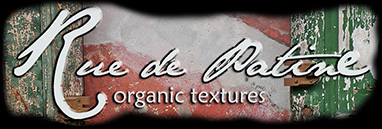
Exhibition
text
“Rue de Patine” (the patina of the streets) is a visual celebration of
the French Quarter in New Orleans. A rich diverse history and the
ability to adapt and survive has served its people well for many
centuries.
Every wall, door, sidewalk and street is a kaleidoscope of colors and
textures. This patina is a source of great pride to the natives (rather
like someone being proud of a scar on their body.)
Layer upon layer of character is exhibited on an ever-changing canvas.
Structures that have survived hurricanes, floods, fires and other
catastrophes proudly stand as a fitting testimony to the survival of a
unique people.
Caribbean hues boldly mix with Spanish and French architecture: an
amazing collision of cultures, like some amazing Creole technicolor
dream.
You may initially dismiss these exhibition images as simply fragments
of ordinary objects,
but you are invited to look deeper to find an abstract emotional beauty
– intimate portraits of an extraordinary people and their breathtaking
home.
Technical data
All
images obtained digitally with a Pentax K20D camera and Pentax lenses,
Velbon carbon fiber tripod with Manfrotto ball head.
Images
captured in 14.6MP RAW format. Absolutely no filters, cropping or
manipulations of any kind (other than resizing the original 23MB files
down to an online-viewable JPG format.)
HDR images joined with Photomatrix Pro 4.0.2 software.
Print
sales
Contact
the artist: printsales@robertmiller.org
View
Robert Miller's other French Quarter (black & white large format)
exhibition: Patina
& Obituaries of the Vieux Carre
A
brief history of The French Quarter
Founded
as a military-style grid of seventy squares in 1718 by French Canadian
naval officer Jean Baptiste Bienville, the French Quarter of New
Orleans has charted a course of urbanism for parts of four centuries.
In
1762 the indifferent Louis XV transferred Louisiana to his Bourbon
cousin Charles III of Spain. Emboldened by a period of Spanish
vacillation in taking power, Francophile colonists staged a revolution
in 1768, summarily squelched by Alejandro O'Reilly with a firing squad
at the Esplanade fort. Spanish rule lasted for four decades, imparting
a legacy of semi-fortified streetscapes, common-wall plastered brick
houses, and walled courtyards used as gardens and utility spaces with
separate servants' quarters and kitchens. Olive oil cooking and
graceful wrought iron balconies, hinges and locks in curvilinear
shapes, and strong vestiges of civil law remain from the Spanish
presence. After great fires of 1788 and 1794, the Cabildo or town hall,
Presbytere or priests' residence, and ironically the "French" Market,
arose to take a permanent place in French Quarter history.
The
1803 Louisiana Purchase, signed within the elegant salon of the
Cabildo, transferred the colony to the United States, inaugurating an
era of prosperity. American culture made slow inroads, largely owing to
the arrival of 10,000 refugees of the French and Haitian Revolutions
and Napoleonic wars. The "glorious victory" of the 1815 Battle of New
Orleans, led by Indian fighter and future president Andrew Jackson over
numerically superior British forces, fixed loyalty to the American
nation. The French Quarter's golden era followed as cotton, sugar and
steamboats poured into the city. American, Irish, German, African and
"Foreign French" immigrants swelled the population, creating a
heterogeneous matrix of culture, language, religion and cuisine.
Civil
War and Reconstruction, played out politically on the streets of the
French Quarter, put an end to prosperity and inaugurated a tug of war
between reform and machine factions as the Old Square declined. Creoles
moved to Esplanade and later Uptown, and famine-driven Sicilian
immigrants found cramped lodging in the grand spaces of French Quarter
mansions of the 1890s. The 1900 birth of jazz in nearby Storyville
nurtured musical legends Jelly Roll Morton, Louis Armstrong, Buddy
Bolden, King Oliver, Bunk Johnson, Nick LaRocca, and other jazz and
ragtime greats. By 1920 the legacy of a storied past first celebrated
by George Washington Cable and Lafcadio Hearn in the 1880s attracted
writers and artists in increasing numbers. William Faulkner, Sherwood
Anderson, Tennessee Williams and Truman Capote were among American
writers attracted to the French Quarter for its freewheeling urbanism,
quaint surroundings and creative stimulus, even as the building stock
declined.
1936
marked the onset of regulatory controls in the form of the
state-sanctioned Vieux Carré Commission. Residents dug in to
preserve the quaint and distinctive character of the old Quarter as art
galleries and antique stores sprouted on Royal Street and brassy
Dixieland-style jazz flourished in Bourbon Street nightclubs and strip
joints. By 1960, with traditional jazz in decline, Preservation Hall
emerged to serve beleaguered musicians. Here Sweet Emma Barrett and
other traditional and largely African-American musicians found
appreciative and sober audiences. Today, these and other preservation
battles are the order of the day as increasing pressure from a
tourist-driven economy lures some 10 million visitors annually to the
time and foot-worn streets of the Vieux Carré.

